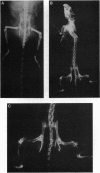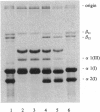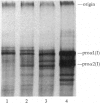Abstract
Osteogenesis imperfecta (OI) is a heritable disorder of connective tissue associated with fractures, osteopenia, and short stature. OI results from mutations affecting the pro alpha 1 or pro alpha 2 gene of type I collagen. We describe a strain of mice with a nonlethal recessively inherited mutation (oim) that results in phenotypic and biochemical features that simulate moderate to severe human OI. The phenotype of homozygous oim mice includes skeletal fractures, limb deformities, generalized osteopenia, and small body size. Their femurs are smaller and demonstrate marked cortical thinning and fewer medullary trabeculae than those of wild-type mice. Breeding studies show the mutation is inherited in most crosses as a single recessive gene on chromosome 6, near the murine Cola-2 gene. Biochemical analysis of skin and bone, as well as isolated dermal fibroblast cultures, demonstrate that alpha 1(I) homotrimeric collagen accumulates in these tissues and is secreted by fibroblasts. Short labeling studies in fibroblasts demonstrate an absence of pro alpha 2(I) collagen chains. Nucleotide sequencing of the cDNA encoding the COOH-propeptide reveals a G deletion at pro alpha 2(I) nucleotide 3983; this results in an alteration of the sequence of the last 48 amino acids. The oim mouse will facilitate the study of type I collagen-related skeletal disease.
Full text
PDF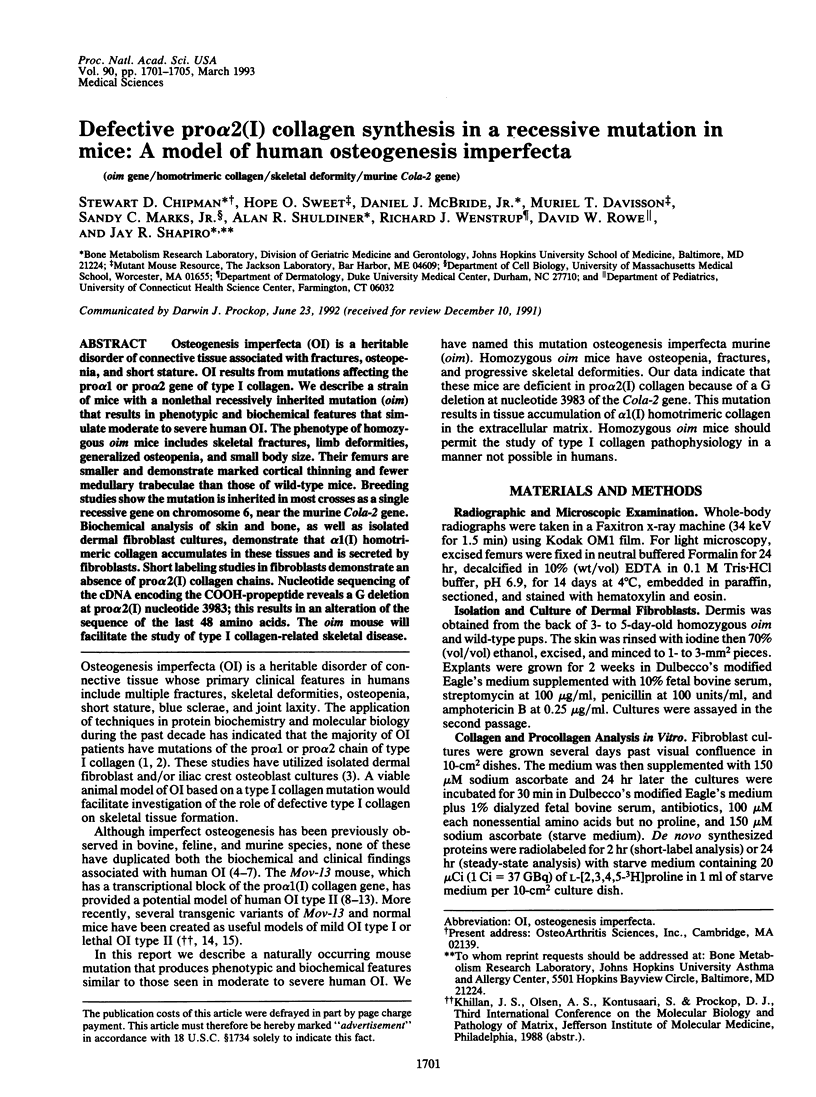
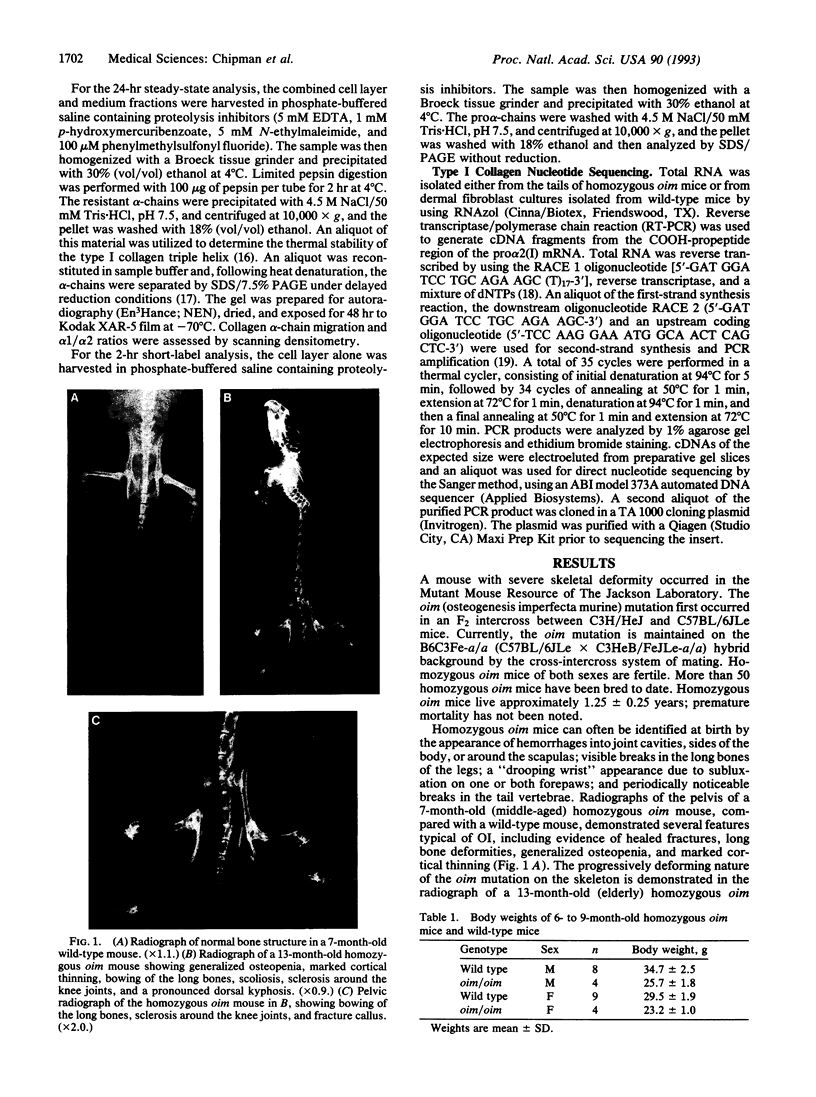
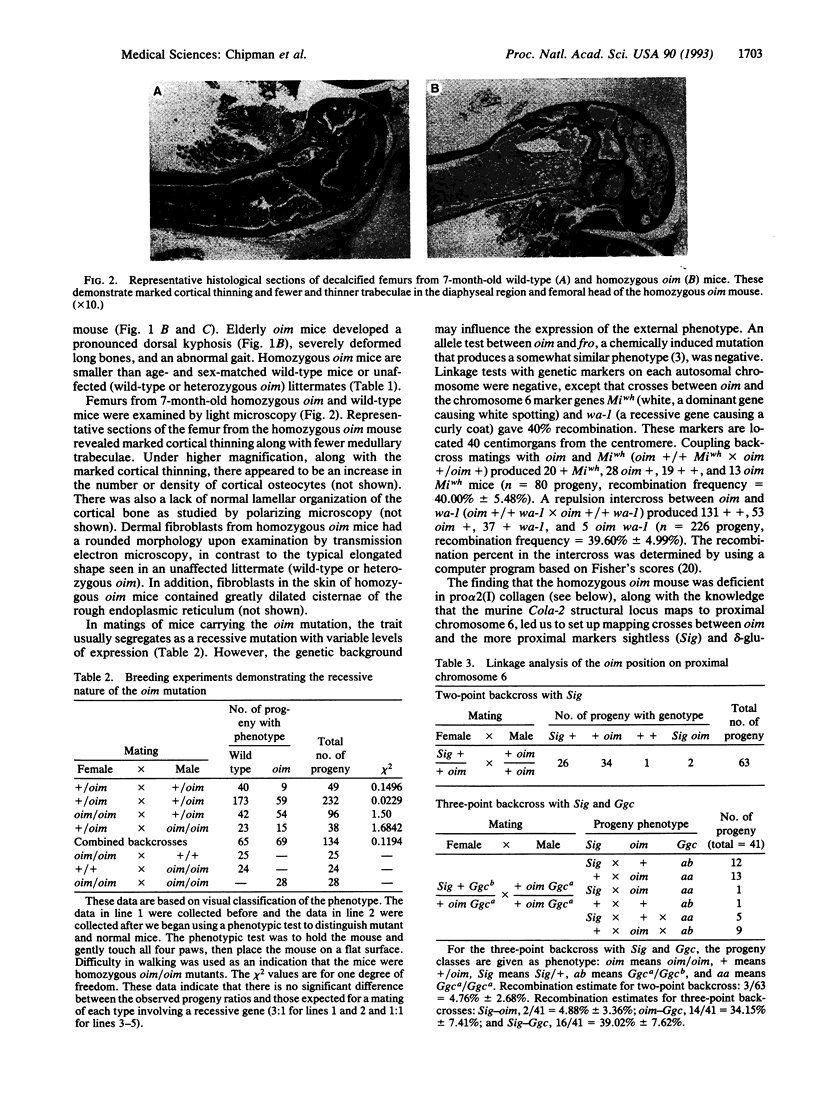
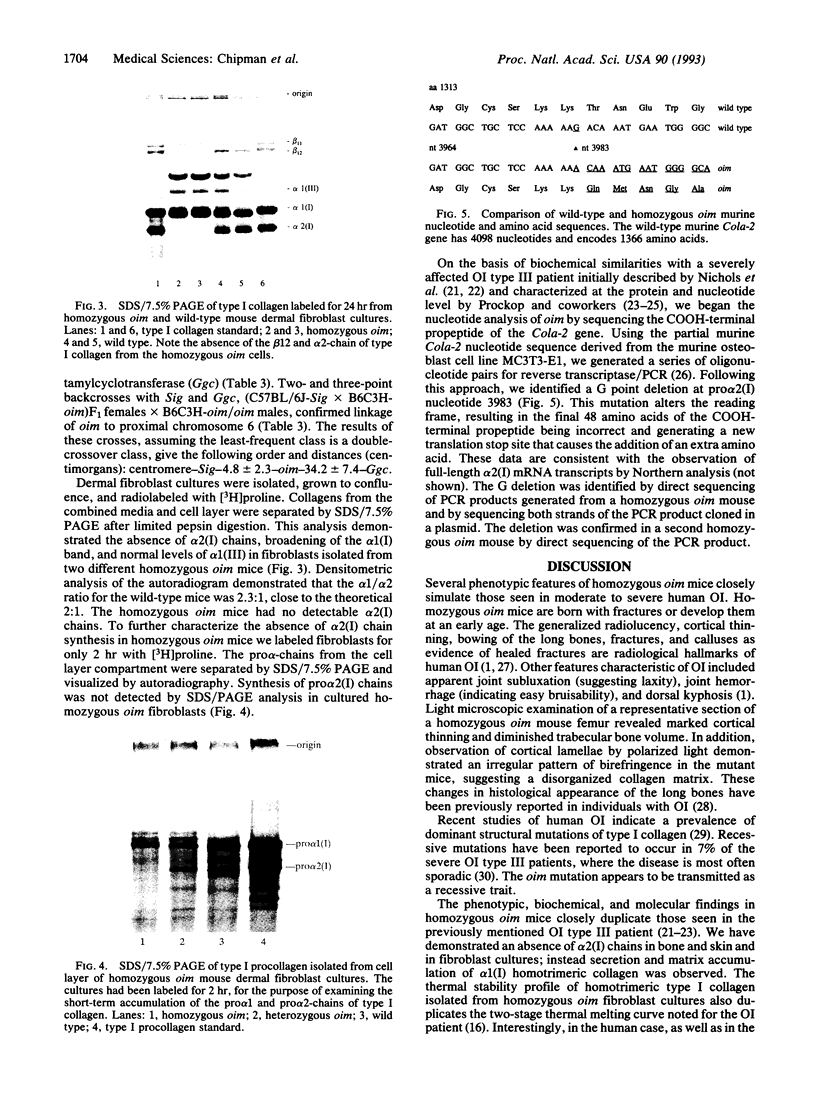
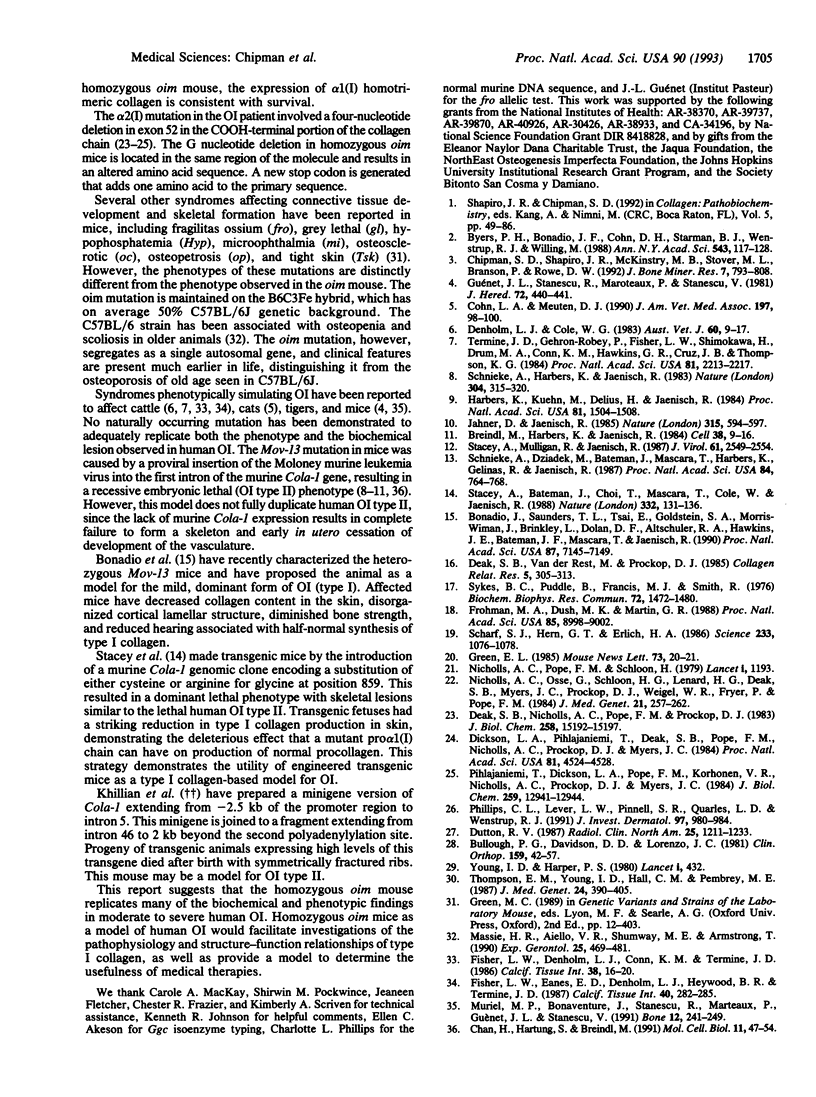
Images in this article
Selected References
These references are in PubMed. This may not be the complete list of references from this article.
- Bonadio J., Saunders T. L., Tsai E., Goldstein S. A., Morris-Wiman J., Brinkley L., Dolan D. F., Altschuler R. A., Hawkins J. E., Jr, Bateman J. F. Transgenic mouse model of the mild dominant form of osteogenesis imperfecta. Proc Natl Acad Sci U S A. 1990 Sep;87(18):7145–7149. doi: 10.1073/pnas.87.18.7145. [DOI] [PMC free article] [PubMed] [Google Scholar]
- Breindl M., Harbers K., Jaenisch R. Retrovirus-induced lethal mutation in collagen I gene of mice is associated with an altered chromatin structure. Cell. 1984 Aug;38(1):9–16. doi: 10.1016/0092-8674(84)90521-x. [DOI] [PubMed] [Google Scholar]
- Bullough P. G., Davidson D. D., Lorenzo J. C. The morbid anatomy of the skeleton in osteogenesis imperfecta. Clin Orthop Relat Res. 1981 Sep;(159):42–57. [PubMed] [Google Scholar]
- Byers P. H., Bonadio J. F., Cohn D. H., Starman B. J., Wenstrup R. J., Willing M. C. Osteogenesis imperfecta: the molecular basis of clinical heterogeneity. Ann N Y Acad Sci. 1988;543:117–128. doi: 10.1111/j.1749-6632.1988.tb55324.x. [DOI] [PubMed] [Google Scholar]
- Chan H., Hartung S., Breindl M. Retrovirus-induced interference with collagen I gene expression in Mov13 fibroblasts is maintained in the absence of DNA methylation. Mol Cell Biol. 1991 Jan;11(1):47–54. doi: 10.1128/mcb.11.1.47. [DOI] [PMC free article] [PubMed] [Google Scholar]
- Chipman S. D., Shapiro J. R., McKinstry M. B., Stover M. L., Branson P., Rowe D. W. Expression of mutant alpha (I)-procollagen in osteoblast and fibroblast cultures from a proband with osteogenesis imperfecta type IV. J Bone Miner Res. 1992 Jul;7(7):793–805. doi: 10.1002/jbmr.5650070709. [DOI] [PubMed] [Google Scholar]
- Cohn L. A., Meuten D. J. Bone fragility in a kitten: an osteogenesis imperfecta-like syndrome. J Am Vet Med Assoc. 1990 Jul 1;197(1):98–100. [PubMed] [Google Scholar]
- Deak S. B., Nicholls A., Pope F. M., Prockop D. J. The molecular defect in a nonlethal variant of osteogenesis imperfecta. Synthesis of pro-alpha 2(I) chains which are not incorporated into trimers of type I procollagen. J Biol Chem. 1983 Dec 25;258(24):15192–15197. [PubMed] [Google Scholar]
- Deak S. B., van der Rest M., Prockop D. J. Altered helical structure of a homotrimer of alpha 1(I)chains synthesized by fibroblasts from a variant of osteogenesis imperfecta. Coll Relat Res. 1985 Sep;5(4):305–313. doi: 10.1016/s0174-173x(85)80020-0. [DOI] [PubMed] [Google Scholar]
- Denholm L. J., Cole W. G. Heritable bone fragility, joint laxity and dysplastic dentin in Friesian calves: a bovine syndrome of osteogenesis imperfecta. Aust Vet J. 1983 Jan;60(1):9–17. doi: 10.1111/j.1751-0813.1983.tb02799.x. [DOI] [PubMed] [Google Scholar]
- Dickson L. A., Pihlajaniemi T., Deak S., Pope F. M., Nicholls A., Prockop D. J., Myers J. C. Nuclease S1 mapping of a homozygous mutation in the carboxyl-propeptide-coding region of the pro alpha 2(I) collagen gene in a patient with osteogenesis imperfecta. Proc Natl Acad Sci U S A. 1984 Jul;81(14):4524–4528. doi: 10.1073/pnas.81.14.4524. [DOI] [PMC free article] [PubMed] [Google Scholar]
- Dutton R. V. A practical radiologic approach to skeletal dysplasias in infancy. Radiol Clin North Am. 1987 Nov;25(6):1211–1233. [PubMed] [Google Scholar]
- Fisher L. W., Denholm L. J., Conn K. M., Termine J. D. Mineralized tissue protein profiles in the Australian form of bovine osteogenesis imperfecta. Calcif Tissue Int. 1986 Jan;38(1):16–20. doi: 10.1007/BF02556589. [DOI] [PubMed] [Google Scholar]
- Fisher L. W., Eanes E. D., Denholm L. J., Heywood B. R., Termine J. D. Two bovine models of osteogenesis imperfecta exhibit decreased apatite crystal size. Calcif Tissue Int. 1987 May;40(5):282–285. doi: 10.1007/BF02555262. [DOI] [PubMed] [Google Scholar]
- Frohman M. A., Dush M. K., Martin G. R. Rapid production of full-length cDNAs from rare transcripts: amplification using a single gene-specific oligonucleotide primer. Proc Natl Acad Sci U S A. 1988 Dec;85(23):8998–9002. doi: 10.1073/pnas.85.23.8998. [DOI] [PMC free article] [PubMed] [Google Scholar]
- Guenet J. L., Stanescu R., Maroteaux P., Stanescu V. Fragilitas ossium: a new autosomal recessive mutation in the mouse. J Hered. 1981 Nov-Dec;72(6):440–441. doi: 10.1093/oxfordjournals.jhered.a109554. [DOI] [PubMed] [Google Scholar]
- Harbers K., Kuehn M., Delius H., Jaenisch R. Insertion of retrovirus into the first intron of alpha 1(I) collagen gene to embryonic lethal mutation in mice. Proc Natl Acad Sci U S A. 1984 Mar;81(5):1504–1508. doi: 10.1073/pnas.81.5.1504. [DOI] [PMC free article] [PubMed] [Google Scholar]
- Jähner D., Jaenisch R. Retrovirus-induced de novo methylation of flanking host sequences correlates with gene inactivity. Nature. 1985 Jun 13;315(6020):594–597. doi: 10.1038/315594a0. [DOI] [PubMed] [Google Scholar]
- Massie H. R., Aiello V. R., Shumway M. E., Armstrong T. Calcium, iron, copper, boron, collagen, and density changes in bone with aging in C57BL/6J male mice. Exp Gerontol. 1990;25(5):469–481. doi: 10.1016/0531-5565(90)90035-z. [DOI] [PubMed] [Google Scholar]
- Muriel M. P., Bonaventure J., Stanescu R., Maroteaux P., Guénet J. L., Stanescu V. Morphological and biochemical studies of a mouse mutant (fro/fro) with bone fragility. Bone. 1991;12(4):241–248. doi: 10.1016/8756-3282(91)90070-y. [DOI] [PubMed] [Google Scholar]
- Nicholls A. C., Osse G., Schloon H. G., Lenard H. G., Deak S., Myers J. C., Prockop D. J., Weigel W. R., Fryer P., Pope F. M. The clinical features of homozygous alpha 2(I) collagen deficient osteogenesis imperfecta. J Med Genet. 1984 Aug;21(4):257–262. doi: 10.1136/jmg.21.4.257. [DOI] [PMC free article] [PubMed] [Google Scholar]
- Nicholls A. C., Pope F. M., Schloon H. Biochemical heterogeneity of osteogenesis imperfecta: New variant. Lancet. 1979 Jun 2;1(8127):1193–1193. doi: 10.1016/s0140-6736(79)91872-5. [DOI] [PubMed] [Google Scholar]
- Phillips C. L., Lever L. W., Pinnell S. R., Quarles L. D., Wenstrup R. J. Construction of a full-length murine pro alpha 2(I) collagen cDNA by the polymerase chain reaction. J Invest Dermatol. 1991 Dec;97(6):980–984. doi: 10.1111/1523-1747.ep12491894. [DOI] [PubMed] [Google Scholar]
- Pihlajaniemi T., Dickson L. A., Pope F. M., Korhonen V. R., Nicholls A., Prockop D. J., Myers J. C. Osteogenesis imperfecta: cloning of a pro-alpha 2(I) collagen gene with a frameshift mutation. J Biol Chem. 1984 Nov 10;259(21):12941–12944. [PubMed] [Google Scholar]
- Scharf S. J., Horn G. T., Erlich H. A. Direct cloning and sequence analysis of enzymatically amplified genomic sequences. Science. 1986 Sep 5;233(4768):1076–1078. doi: 10.1126/science.3461561. [DOI] [PubMed] [Google Scholar]
- Schnieke A., Dziadek M., Bateman J., Mascara T., Harbers K., Gelinas R., Jaenisch R. Introduction of the human pro alpha 1(I) collagen gene into pro alpha 1(I)-deficient Mov-13 mouse cells leads to formation of functional mouse-human hybrid type I collagen. Proc Natl Acad Sci U S A. 1987 Feb;84(3):764–768. doi: 10.1073/pnas.84.3.764. [DOI] [PMC free article] [PubMed] [Google Scholar]
- Schnieke A., Harbers K., Jaenisch R. Embryonic lethal mutation in mice induced by retrovirus insertion into the alpha 1(I) collagen gene. 1983 Jul 28-Aug 3Nature. 304(5924):315–320. doi: 10.1038/304315a0. [DOI] [PubMed] [Google Scholar]
- Stacey A., Bateman J., Choi T., Mascara T., Cole W., Jaenisch R. Perinatal lethal osteogenesis imperfecta in transgenic mice bearing an engineered mutant pro-alpha 1(I) collagen gene. Nature. 1988 Mar 10;332(6160):131–136. doi: 10.1038/332131a0. [DOI] [PubMed] [Google Scholar]
- Stacey A., Mulligan R., Jaenisch R. Rescue of type I collagen-deficient phenotype by retroviral-vector-mediated transfer of human pro alpha 1(I) collagen gene into Mov-13 cells. J Virol. 1987 Aug;61(8):2549–2554. doi: 10.1128/jvi.61.8.2549-2554.1987. [DOI] [PMC free article] [PubMed] [Google Scholar]
- Sykes B., Puddle B., Francis M., Smith R. The estimation of two collagens from human dermis by interrupted gel electrophoresis. Biochem Biophys Res Commun. 1976 Oct 18;72(4):1472–1480. doi: 10.1016/s0006-291x(76)80180-5. [DOI] [PubMed] [Google Scholar]
- Termine J. D., Robey P. G., Fisher L. W., Shimokawa H., Drum M. A., Conn K. M., Hawkins G. R., Cruz J. B., Thompson K. G. Osteonectin, bone proteoglycan, and phosphophoryn defects in a form of bovine osteogenesis imperfecta. Proc Natl Acad Sci U S A. 1984 Apr;81(7):2213–2217. doi: 10.1073/pnas.81.7.2213. [DOI] [PMC free article] [PubMed] [Google Scholar]
- Thompson E. M., Young I. D., Hall C. M., Pembrey M. E. Recurrence risks and prognosis in severe sporadic osteogenesis imperfecta. J Med Genet. 1987 Jul;24(7):390–405. doi: 10.1136/jmg.24.7.390. [DOI] [PMC free article] [PubMed] [Google Scholar]
- Young I. D., Harper P. S. Recurrence risk in osteogenesis imperfecta congenita. Lancet. 1980 Feb 23;1(8165):432–432. doi: 10.1016/s0140-6736(80)90988-5. [DOI] [PubMed] [Google Scholar]



